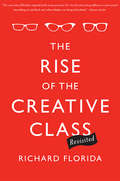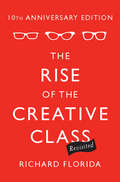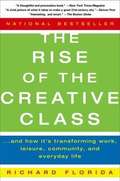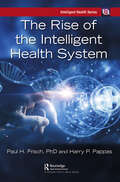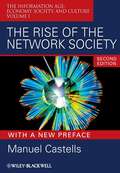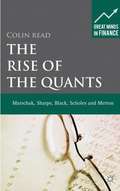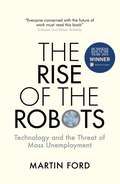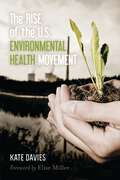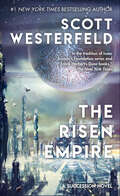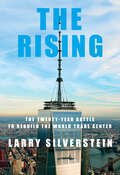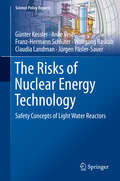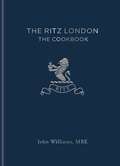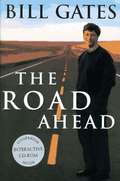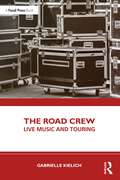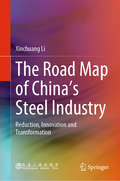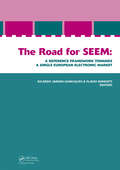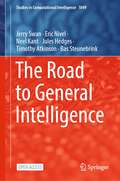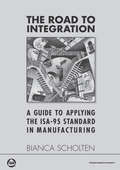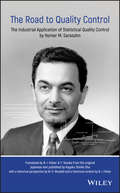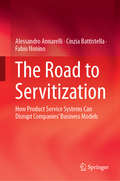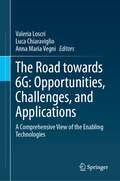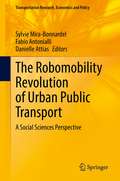- Table View
- List View
The Rise of the Creative Class, Revisited
by Richard FloridaInitially published in 2002, The Rise of the Creative Class quickly achieved classic status for its identification of forces then only beginning to reshape our economy, geography, and workplace. Weaving story-telling with original research, Richard Florida identified a fundamental shift linking a host of seemingly unrelated changes in American society: the growing importance of creativity in people’s work lives and the emergence of a class of people unified by their engagement in creative work. Millions of us were beginning to work and live much as creative types like artists and scientists always had, Florida observed, and this Creative Class was determining how the workplace was organized, what companies would prosper or go bankrupt, and even which cities would thrive. In The Rise of the Creative Class Revisited, Florida further refines his occupational, demographic, psychological, and economic profile of the Creative Class, incorporates a decade of research, and adds five new chapters covering the global effects of the Creative Class and exploring the factors that shape "quality of place” in our changing cities and suburbs.
The Rise of the Creative Class--Revisited
by Richard FloridaThe Washington Monthly 2002 Annual Political Book Award WinnerThe Rise of the Creative Class gives us a provocative new way to think about why we live as we do today-and where we might be headed. Weaving storytelling with masses of new and updated research, Richard Florida traces the fundamental theme that runs through a host of seemingly unrelated changes in American society: the growing role of creativity in our economy. Just as William Whyte's 1956 classic The Organization Man showed how the organizational ethos of that age permeated every aspect of life, Florida describes a society in which the creative ethos is increasingly dominant. Millions of us are beginning to work and live much as creative types like artists and scientists always have-with the result that our values and tastes, our personal relationships, our choices of where to live, and even our sense and use of time are changing. Leading the shift are the nearly 38 million Americans in many diverse fields who create for a living-the Creative Class. The Rise of the Creative Class chronicles the ongoing sea of change in people's choices and attitudes, and shows not only what's happening but also how it stems from a fundamental economic change. The Creative Class now comprises more than thirty percent of the entire workforce. Their choices have already had a huge economic impact. In the future they will determine how the workplace is organized, what companies will prosper or go bankrupt, and even which cities will thrive or wither.
The Rise of the Creative Class: And How It's Transforming Work, Leisure, Community and Everyday Life
by Richard L. FloridaThe Rise of the Creative Class gives a provocative way to think about why people live as they do today and where they might be headed. Weaving storytelling with masses of new and updated research, Florida traces the role of creativity in the economy.
The Rise of the Intelligent Health System (Intelligent Health Series)
by Harry P. Pappas Paul H. Frisch"I recommend that all members of the health community read this book to obtain a real snapshot of how the Intelligent Health System is being transformed via new technologies." Chris Landon MD FAAP, FCCP, FRSM Clinical Associate Professor USC Keck School of Medicine Technology Development Center Laboratory and Studio The "Intelligent Health Pavilion" as demonstrated at the annual HIMSS Conference by the Intelligent Health Association is the impetus for this book. This book documents the remarkable journey of "Intelligent Health System" and the adoption of Innovative technologies. Many showcased in real time on the trade show floor and now in this book: "The Rise of the Intelligent Health System". In each chapter of this book, authors are expressing the immense potential of merging cutting-edge technology with the complex realm of patient care and safety. The informative chapters in this book delve deep into the unfolding story of how hospitals have evolved into interactive, intelligent environments, driven by real-time data and powered by artificial intelligence. In what seems like the blink of an eye, technology has completely transformed the way we live, work, and interact with the world around us. From smartphones to self-driving cars, ChatGPT, wireless technologies, wearables, and many other innovations are reshaping our society, pushing the boundaries of what was once considered impossible. However, nowhere is the impact of technology more profound than in the field of healthcare.
The Rise of the Network Society: Economy, Society, and Culture (2nd edition)
by Manuel CastellsThis first book in Castells' groundbreaking trilogy, with a substantial new preface, highlights the economic and social dynamics of the information age and shows how the network society has now fully risen on a global scale. Groundbreaking volume on the impact of the age of information on all aspects of society Includes coverage of the influence of the internet and the net-economy Describes the accelerating pace of innovation and social transformation Based on research in the USA, Asia, Latin America, and Europe
The Rise of the Quants
by Colin ReadThe third book in the Great Minds in Finance series examines the pricing of securities and the risk/reward trade off through the legends, contribution, and legacies of Jacob Marschak, William Sharpe, Fischer Black and Myron Scholes, and Robert Merton, influencing both theory and practice, answering the question 'how do we measure risk?'
The Rise of the Robots: Technology and the Threat of Mass Unemployment
by Martin FordIntelligent algorithms are already well on their way to making white collar jobs obsolete: travel agents, data-analysts, and paralegals are currently in the firing line. In the near future, doctors, taxi-drivers and ironically even computer programmers are poised to be replaced by 'robots'. Without a radical reassessment of our economic and political structures, we risk the very implosion of the capitalist economy itself.In Rise of the Robots, technology expert Martin Ford systematically outlines the achievements of artificial intelligence and uses a wealth of economic data to illustrate the terrifying societal implications. From health and education to finance and technology, his warning is start - all jobs that are on some level routine are like to eventually be automated, resulting in the death of traditional careers and a hollowed-out middle class. The robots are coming and we have to decide - now - whether the future will bring prosperity or catastrophe.
The Rise of the U.S. Environmental Health Movement
by Kate Davies“Tells the story of anger, disillusionment, and determination of Americans to develop a political movement to fight chemical pollution . . . timely.” —The Huffington PostThis book, named one of Booklist’s Top 10 books on sustainability in 2014, is the first to offer a comprehensive examination of the environmental health movement, which unlike many parts of the environmental movement, focuses on ways toxic chemicals and other hazardous agents in the environment effect human health and well-being. Born in 1978 when Lois Gibbs organized her neighbors to protest the health effects of a toxic waste dump in Love Canal, New York, the movement has spread across the United States and throughout the world. By placing human health at the center of its environmental argument, this movement has achieved many victories in community mobilization and legislative reform. In The Rise of the U.S. Environmental Health Movement, environmental health expert Kate Davies describes the movement’s historical, ideological, and cultural roots and analyzes its strategies and successes.“Kate Davies’ excellent book focuses on the role of health in the environmental health movement and encourages us to consider its origins and accomplishments . . . The Rise of the U.S. Environmental Health Movement looks both back and forward to challenge us to consider our current direction. In the future this book will provide readers with an important perspective on how the environmental health movement shaped our society.” —Toxipedia“A well-done history of America’s environmental health movement . . . offers readers valuable information on how grassroots organizing prevents harm from toxic exposures and leads to safe and healthy communities.” —Lois Marie Gibbs, Executive Director, Center for Health, Environment & Justice
The Risen Empire: Book One Of Succession (Succession #1)
by Scott Westerfeld“Westerfeld’s blend of traditional space opera and cutting-edge speculation makes this a truly twenty-first-century SF novel.” —Karl Schroeder, author of Pirate SunThe undead Emperor has ruled his mighty interstellar empire of eighty human worlds for sixteen hundred years. Because he can grant a form of eternal life, creating an elite known as the Risen, his power has been absolute. He and his sister, the Child Empress, who is eternally a little girl, are worshiped as living gods. No one can touch them.Not until the Rix, machine-augmented humans who worship very different gods: AI compound minds of planetary extent. The Rix are cool, relentless fanatics, and their only goal is to propagate such AIs throughout the galaxy. They seek to end, by any means necessary, the Emperor’s prolonged tyranny of one and supplant it with an eternal cybernetic dynasty of their own. They begin by taking the Child Empress hostage. Captain Laurent Zai of the Imperial Frigate Lynx is tasked with her rescue.Separated by light-years, bound by an unlikely love, Zai and pacifist senator Nara Oxham must each in their own way, face the challenge of the Rix, and they each will hold the fate of the empire in their hands. The Risen Empire is the first great space opera of the twenty-first century.“In the tradition of Isaac Asimov’s Foundation series and Frank Herbert’s Dune books.” —The New York Times“Confirms the buzz that space opera is one of the most exciting branches of current SF.” —Publishers Weekly (starred review)
The Rising: The Twenty-Year Battle to Rebuild the World Trade Center
by Larry SilversteinThe never-before-told inside story of the rebuilding of the World Trade Center — an epic tale of business, politics, and engineering by the man who spent two decades working to make it happenAfter the terrorist attacks of 9/11 destroyed the World Trade Center, New Yorkers and Americans faced a critical set of questions: What should be done with the site? Could the towers be replaced? And how best to memorialize those lost on that day? For Larry Silverstein, a lifelong New Yorker who had signed a lease for the properties just a few months before the attacks, the answer was clear: America had to rebuild as quickly as possible.In The Rising, Silverstein recounts in vivid detail his long battle to construct a new World Trade Center complex and to revitalize the surrounding neighborhood while also memorializing the victims of the attacks. Silverstein made history in 2001 when he signed a 99-year lease on the 10.6-million-square-foot World Trade Center for $3.25 billion. For the next twenty years, he navigated warring political interests, byzantine city bureaucracies, and resistant insurance companies, as well as the many challenges of designing, engineering, and constructing several new towers in the heart of downtown Manhattan. More than once the entire project almost folded, but today the buildings are nearly complete and the neighborhood is once again a thriving hub that draws hundreds of thousands of people a day.The Rising is a vibrant portrait of the inner workings of New York City in the wake of its most profound tragedy, but it is also a master class in how to succeed in business despite all odds. Full of outsize characters and relentless adversity, this is a riveting book about a remarkable feat of vision and determination.
The Risk of Water Conflicts in Aotearoa-New Zealand: Emergence and Intensification
by Adan E. SuazoThis book focuses on water disputes in New Zealand: a country where such conflicts are assumed to be non-existing. Rarely are water disputes examined in areas where water resources abound, and where the political framework that governs their access and use is strong. Environmental security literature has devoted a significant amount of attention to the nexus between resource abundance and conflict. Important research has assessed this relationship by focusing on non-renewable resource wealth as a causal determinant of conflict, but little is known about the conditions that influence the emergence and intensification of conflict in water abundant environments. By most accounts, New Zealand is one of the most water-rich countries in the world. Even though violent conflict over water does not normally materialize in New Zealand, conflicts and incompatible claims motivated by water bottling, the growth of some types of agriculture, tourism, and water treatment strategies, continue to surface. Little, however, is known about how and why these conflicts emerge and intensify in a country such as New Zealand. To address this lacuna, this project asks the following research question: How and why does the commercialization of freshwater influence the emergence and intensification of hydropolitical conflict in New Zealand? This study presents two central arguments. First, that the introduction of a commercial enterprise motivates the emergence of hydropolitical conflict intentionality if the enterprise is incompatible with the interests of local communities. And second, hydropolitical conflict risk intensifies in accordance with the level of trust that communities pose upon the approval and appeals process that supports a commercial operation. To test these arguments, this study examines the effects of water bottling and water chlorination on the towns of Ashburton (Canterbury) and Glenorchy (Otago), by employing a tripartite analysis comprised, first, of a conflict intentionality and engagement assessment, second, of a comparative case study analysis, and third, of a conflict intentionality classification. The data suggests that hydropolitical conflict risk is low when communities trust the approval and appeals process behind any given commercial operation. Water-based conflict risk however is likely to escalate when local communities lose trust in the above processes and the institutions that administer them.
The Risks of Nuclear Energy Technology
by Günter Kessler Anke Veser Franz-Hermann Schlüter Wolfgang Raskob Claudia Landman Jürgen Päsler-SauerThe book analyses the risks of nuclear power stations. The security concept of reactors is explained. Measures against the spread of radioactivity after a severe accident, accidents of core melting and a possible crash of an air plane on reactor containment are discussed. The book covers three scientific subjects of the safety concepts of Light Water Reactors: - A first part describes the basic safety design concepts of operating German Pressurized Water Reactors and Boiling Water Reactors including accident management measures introduced after the reactor accidents of Three Mile Island and Chernobyl. These safety concepts are also compared with the experiences of the Fukushima accidents. In addition, the safety design concepts of the future modern European Pressurized Water Reactor (EPR) and of the future modern Boiling Water Reactor SWR-1000 (KERENA) are presented. These are based on new safety research results of the past decades. - In a second, part the possible crash of military or heavy commercial air planes on reactor containment is analyzed. It is shown that reactor containments can be designed to resist to such an airplane crash. - In a third part, an online decision system is presented. It allows to analyze the distribution of radioactivity in the atmosphere and to the environment after a severe reactor accident. It provides data for decisions to be taken by authorities for the minimization of radiobiological effects to the population. This book appeals to readers who have an interest in save living conditions and some understanding for physics or engineering.
The Ritz London: The Cookbook
by John Williams The Ritz Hotel (London) LimitedAS SEEN ON TVAs featured on ITV's 'Inside the Ritz' series 'When you look at the dishes in this book, the photographs - it's beyond beautiful. You wouldn't need to cook a thing. You could just flick through these pages - it is a proper feast for the eyes.' - Graham Norton 'As sumptuous as Williams's exquisite cooking, this is a magnificent volume. And a fitting tribute to one of the world's great restaurants. The recipes aren't simple but this is one of those books to immerse yourself in. Five-star brilliance.' - Tom Parker Bowles, Mail on Sunday'Less a classic cookbook than a contemporary guide to gracious living... Subdividing its contents into four seasons, each is introed with a classic cocktail, and there are contributions from The Ritz's stellar staff. But really this is Williams's show, a masterclass in munificence...' - British GQ'A real tour de force ... Definitely the stand-out recipe book of the year for me.' - The Caterer'John Williams's food at the Piccadilly institution is revered. Now it has brought out the cookbook so you can recreate the magic at home.' - ES Magazine'Part technical recipe book, part memoir. There are Williams's memories of growing up in South Shields, the son of a trawlerman, who accompanied his mother on shopping trips to the butcher and developed a precocious taste for tripe and Jersey Royals. As for the recipes, certain classics are within the range of the dinner-party cook (salt-baked celeriac, for instance, or venison Wellington).' - Telegraph 'A work of art, full of recipes exactly as they are made in the Ritz kitchen, beautifully photographed by John Carey. Marvel at the sheer amount of work and skill that goes into each dish, the processes and the perfectionism - and maybe start with the recipe for scones on page 112.' - hot-dinners.com'... As an exemplar of classic and timeless dishes, it is an invaluable book that lets the reader peer behind the screen of one of the capital's most enduring institutions. For Williams' anecdote on the eating habits of the late Margaret Thatcher, it is worth the cover price alone.' - Big Hospitality'Distinctive cookbook... This upscale offering is wholly in keeping with its subject: elegant, carefully studied, and more aspirational than practical.' - Publishers WeeklyThe Ritz: The Quintessential Cookbook is the first book to celebrate recipes of the dishes served today, at lunch and at dinner. The book features 100 delicious recipes, such as Roast scallops bergamot & avocado, Saddle of lamb belle époque and Grand Marnier Soufflé, and is divided into the four seasons: spring, summer, autumn and winter.The recipes reflect the glorious opulence and celebratory ambience of The Ritz; seasonal dishes of fish, shellfish, meat, poultry and game. Desserts include pastries, mousses, ice creams and spectacular, perfectly-risen soufflés. There are recipes that are simple and others for the more ambitious cook, plus helpful tips to guide you at home.Along the way, John Williams shares his culinary philosophy and expertise. For any cook who has wondered how they do it at The Ritz, this book will provide the answers. There will be plenty of entertaining tales about the hotel and unique glimpses of London's finest kitchen beneath ground.
The Ritz London: The Cookbook
by John Williams The Ritz Hotel (London) LimitedAS SEEN ON TVAs featured on ITV's 'Inside the Ritz' series 'When you look at the dishes in this book, the photographs - it's beyond beautiful. You wouldn't need to cook a thing. You could just flick through these pages - it is a proper feast for the eyes.' - Graham Norton 'As sumptuous as Williams's exquisite cooking, this is a magnificent volume. And a fitting tribute to one of the world's great restaurants. The recipes aren't simple but this is one of those books to immerse yourself in. Five-star brilliance.' - Tom Parker Bowles, Mail on Sunday'Less a classic cookbook than a contemporary guide to gracious living... Subdividing its contents into four seasons, each is introed with a classic cocktail, and there are contributions from The Ritz's stellar staff. But really this is Williams's show, a masterclass in munificence...' - British GQ'A real tour de force ... Definitely the stand-out recipe book of the year for me.' - The Caterer'John Williams's food at the Piccadilly institution is revered. Now it has brought out the cookbook so you can recreate the magic at home.' - ES Magazine'Part technical recipe book, part memoir. There are Williams's memories of growing up in South Shields, the son of a trawlerman, who accompanied his mother on shopping trips to the butcher and developed a precocious taste for tripe and Jersey Royals. As for the recipes, certain classics are within the range of the dinner-party cook (salt-baked celeriac, for instance, or venison Wellington).' - Telegraph 'A work of art, full of recipes exactly as they are made in the Ritz kitchen, beautifully photographed by John Carey. Marvel at the sheer amount of work and skill that goes into each dish, the processes and the perfectionism - and maybe start with the recipe for scones on page 112.' - hot-dinners.com'... As an exemplar of classic and timeless dishes, it is an invaluable book that lets the reader peer behind the screen of one of the capital's most enduring institutions. For Williams' anecdote on the eating habits of the late Margaret Thatcher, it is worth the cover price alone.' - Big Hospitality'Distinctive cookbook... This upscale offering is wholly in keeping with its subject: elegant, carefully studied, and more aspirational than practical.' - Publishers WeeklyThe Ritz: The Quintessential Cookbook is the first book to celebrate recipes of the dishes served today, at lunch and at dinner. The book features 100 delicious recipes, such as Roast scallops bergamot & avocado, Saddle of lamb belle époque and Grand Marnier Soufflé, and is divided into the four seasons: spring, summer, autumn and winter.The recipes reflect the glorious opulence and celebratory ambience of The Ritz; seasonal dishes of fish, shellfish, meat, poultry and game. Desserts include pastries, mousses, ice creams and spectacular, perfectly-risen soufflés. There are recipes that are simple and others for the more ambitious cook, plus helpful tips to guide you at home.Along the way, John Williams shares his culinary philosophy and expertise. For any cook who has wondered how they do it at The Ritz, this book will provide the answers. There will be plenty of entertaining tales about the hotel and unique glimpses of London's finest kitchen beneath ground.
The Road Ahead
by Bill Gates Nathan Myhrvold Peter RinearsonIn this book the software pioneer describes how emerging technologies will transform human existence in unprecedented ways.
The Road Crew: Live Music and Touring
by Gabrielle KielichThe Road Crew: Live Music and Touring is an in-depth study of the road crew – the group of workers who handle the logistical and technical requirements of popular music concert tours – that provides an extensive look at the activities and personnel involved in the daily operation of these events. Using interviews with road crew members, participant observation at concert venues and archival research, this book covers a range of topics, including how they learn their roles and maintain work through networks and informal practices, the experience of being on tour and the workplace culture of road crews, the daily tasks and necessary documents that contribute to the realisation of concert events, and the integral role that tour managers play in the working lives of musicians. The book also provides important insights into the experience of women working in a male-dominated field, the ways in which hierarchy shapes the working lives of “support” workers and the effects of touring on road crew members. The Road Crew will be of interest to scholars and students of popular music, live music and the creative industries, as well as music fans, journalists, and professionals and practitioners in the music industries.
The Road Crew: Live Music and Touring
by Gabrielle KielichThe Road Crew: Live Music and Touring is an in-depth study of the road crew – the group of workers who handle the logistical and technical requirements of popular music concert tours – that provides an extensive look at the activities and personnel involved in the daily operation of these events.Using interviews with road crew members, participant observation at concert venues and archival research, this book covers a range of topics, including how they learn their roles and maintain work through networks and informal practices, the experience of being on tour and the workplace culture of road crews, the daily tasks and necessary documents that contribute to the realisation of concert events, and the integral role that tour managers play in the working lives of musicians. The book also provides important insights into the experience of women working in a male-dominated field, the ways in which hierarchy shapes the working lives of “support” workers and the effects of touring on road crew members.The Road Crew will be of interest to scholars and students of popular music, live music and the creative industries, as well as music fans, journalists, and professionals and practitioners in the music industries.
The Road Map of China's Steel Industry: Reduction, Innovation and Transformation
by Xinchuang LiThis book explores the principles of supply-side structural reform and current practices in the Chinese steel industry. Focusing on the general requirements for high-quality development, it reviews the evolution of the global and Chinese steel industries with regard to reduction, innovation, and transformation. It also summarizes industrial development law from a transfer route perspective, analyzes major challenges and opportunities for the steel industry in the new era, and proposes strategic orientation and implementation measures for the future development of the steel industry.The book contends that high-quality development of the steel industry must be driven by innovation, and it is essential to promote integrated development based on several aspects – greenness, coordination, quality, standardization, differentiation, service, intelligence, diversification, and internationalization – in order to reshape the industrial value chain and continuously improve industrial competitiveness. This concept is essential to help Chinese steel companies prepare development plans for transformation and upgrading. Combining thorough analysis, unique insights, and many practical cases, the book offers a guide to and inspiration for future implementation approaches.
The Road for SEEM. A Reference Framework Towards a Single European Electronic Market
by Ricardo Jardim-Goncalves Flavio Bonfatti�Become the most competitive and dynamic knowledge based economy in the world by 2010� is the major objective of the Lisbon strategy for the European Community. The European Commission re-launched the Lisbon strategy in a new initiative called i2010 � a European Information Society for growth and employment, to promote a Single European Information
The Road to General Intelligence (Studies in Computational Intelligence #1049)
by Bas Steunebrink Jerry Swan Eric Nivel Neel Kant Jules Hedges Timothy AtkinsonHumans have always dreamed of automating laborious physical and intellectual tasks, but the latter has proved more elusive than naively suspected. Seven decades of systematic study of Artificial Intelligence have witnessed cycles of hubris and despair. The successful realization of General Intelligence (evidenced by the kind of cross-domain flexibility enjoyed by humans) will spawn an industry worth billions and transform the range of viable automation tasks.The recent notable successes of Machine Learning has lead to conjecture that it might be the appropriate technology for delivering General Intelligence. In this book, we argue that the framework of machine learning is fundamentally at odds with any reasonable notion of intelligence and that essential insights from previous decades of AI research are being forgotten. We claim that a fundamental change in perspective is required, mirroring that which took place in the philosophy of science in the mid 20th century. We propose a framework for General Intelligence, together with a reference architecture that emphasizes the need for anytime bounded rationality and a situated denotational semantics. We given necessary emphasis to compositional reasoning, with the required compositionality being provided via principled symbolic-numeric inference mechanisms based on universal constructions from category theory.• Details the pragmatic requirements for real-world General Intelligence.• Describes how machine learning fails to meet these requirements.• Provides a philosophical basis for the proposed approach.• Provides mathematical detail for a reference architecture.• Describes a research program intended to address issues of concern in contemporary AI.The book includes an extensive bibliography, with ~400 entries covering the history of AI and many related areas of computer science and mathematics.The target audience is the entire gamut of Artificial Intelligence/Machine Learning researchers and industrial practitioners. There are a mixture of descriptive and rigorous sections, according to the nature of the topic. Undergraduate mathematics is in general sufficient. Familiarity with category theory is advantageous for a complete understanding of the more advanced sections, but these may be skipped by the reader who desires an overall picture of the essential conceptsThis is an open access book.
The Road to Integration: A Guide to Applying the ISA-95 Standard in Manufacturing
by Bianca ScholtenIn recent decades, industrial companies have invested much time and money in enterprise resource planning (ERP) systems and in automation of the process control layer. In our quest to reap the rewards of all these investments, the gap between business automation and process automation is becoming painfully obvious. ERP systems are only valuable if you supply them with current data, and these data originate largely from the process control layer. When integrating these systems, both IT departments and engineering departments must confront the high degree of heterogeneity found in technology, metadata, programming languages, user interfaces, and more. Good communication with the system's end user is essential as several departments are usually involved, such as production, maintenance, the lab, and the office. Try speaking the same language then! Against this backdrop, ISA decided in the 1990s to develop the ISA-95 standard for integrating enterprise and control systems in order to reduce the risks, costs, and errors that go hand in hand with implementing manufacturing control systems and integrating them with ERP systems. This handy resource explains how to apply ISA-95 in manufacturing enterprise systems (MES) and vertical integration projects, as well as reveals the most important ISA-95 models and terminology. It is ideal for those just starting out who need to get up to speed on ISA-95's background information but also for those who have some practical experience with ISA-95 and require additional support in carrying out analyses to determine a specific company's MES strategy and to define user requirements. If you develop MES functionality or realize interfaces based on ISA-95, then this guide will help you understand and apply the ISA-95 object models. Most important, the guide explains how to integrate ERP and MES systems using ISA-95. It places ISA-95 in the broader context of modern information exchange technologies and thus offers a complete picture for project managers, consultants, programmers, and information architects who want to integrate ERP and MES systems based on the international standard.
The Road to Quality Control: The Industrial Application of Statistical Quality Control by Homer M. Sarasohn
by Nicholas Fisher Yutaka Tanaka William WoodallProfessor Woodall’s essay shows that this book represents a remarkable contribution, even by today’s standards, because of its contemporary thinking about the relationship between the specific topic of SQC and the broader company context of Quality Management. It also demonstrates the remarkable awareness of at least some young US engineers in the post-war period about the vital role of Statistical Quality Control in establishing and maintaining a competitive position. The book reveals that there was unsuspected knowledge extant immediately post-war, about the importance of Statistical Quality Control when appropriately applied in an industrial setting. It also helps to correct wide-spread historical misconceptions about who specifically was responsible for helping Japanese industry get back on its feet post-war, a task assigned to General Douglas Macarthur by President Truman and how Macarthur was indebted to Sarasohn.
The Road to Servitization: How Product Service Systems Can Disrupt Companies’ Business Models
by Fabio Nonino Cinzia Battistella Alessandro AnnarelliThe book describes state-of-the-art product service systems, and provides a framework to categorize the knowledge surrounding these systems. It discusses the evolution and spread of the servitization model across industries, and explores its current and most relevant applications in industry. Further, the book highlights the model’s strategic value for business and management, operations, and sustainability and shows readers how to enhance service design and implementation. The contributors provide the theory behind servitization as well as the evidence for it, and report practical and industrial lessons learned. Illustrations, charts, and tables effectively guide readers through real-world and potential applications of product service systems, and case studies describing how companies have innovated and developed award winning business models are also included. Moreover, the book exhibits the selection and implementation policies for product service systems in different industrial environments. Providing comprehensive information on the product service system phenomenon, this book is essential reading for researchers and practitioners in the product service and business industries. It is also of interest to students and lecturers in business strategy and service management, as it shows the latest trends shaping the modern contexts in which companies operate.
The Road towards 6G: A Comprehensive View of the Enabling Technologies
by Valeria Loscri Anna Maria Vegni Luca ChiaraviglioThe proposed book will provide a comprehensive picture of the journey from 5G networks towards 6G. Different aspects, ranging from theoretical foundations to existing platforms and technologies will be presented and analysed, by critically highlighting the real opportunities and the challenges. The first chapters are to describe the general “transitioning” aspects from 5G to 6G. After that, an overview on the different technologies is provided, to present at the end the security aspects, the new applications and an analysis of the electromagnetic exposure, above all in terms of comparative in respect of 5G. Security and Application will be straightforward better explained after the big picture on the different technologies is detailed in the previous chapters. 6G is an emerging complex paradigm, with some important new concepts, that would enable an extremely high reliability and low latency. The main purpose is to provide the reader a thorough vision of the enabling technologies, their potential and what is still needed to fill the gap in terms of sustainability and coexistence of the different technologies. Since different emerging technologies will be considered and detailed in the book, it will be interesting for the reader to infer the major opportunities of each and the main limitations. This kind of information will mainly boost the potential interactions of different technologies to provide a more reliable system.
The Robomobility Revolution of Urban Public Transport: A Social Sciences Perspective (Transportation Research, Economics and Policy)
by Danielle Attias Sylvie Mira-Bonnardel Fabio AntonialliOver the past two decades, society has been witnessing how technological, political, and societal changes have been transforming individual and collective urban mobility. Driven both by newcomers and traditional players, by disruptive as well as incremental innovations, the main objective now is to enhance mobility and accessibility while, reducing vehicle ownership, congestion, road accidents, and pollution in cities. This transformation has been mainly enabled by the widespread adoption of internet-connected devices (e.g.: smartphones and tablets) and by the innovative business models, technologies, and use-cases that arose from this rapid digitalization, such as peer-to-peer, and two-sided markets providing several mobility schemes: car-sharing, car-pooling, bike sharing, free-floating (cars, bikes, electric scooter), ridesharing and ride hailing either for long distances as well as for urban and micro-mobility. The book presents – in a holistic perspective – how this revolution is happening and what are the major cornerstones for the implementation of robomobility. It aims at answering several substantial issues, such as: What is robomobility and what does it imply for the different stakeholders of the public transport ecosystem? How do policy makers integrate this innovation and how ready the regulations are? How do citizens take part in this transformation? What is the level of user acceptance for this new type of mobility? What are its environmental impacts? What is the economic impact of deploying these shuttles in a local ecosystem?
